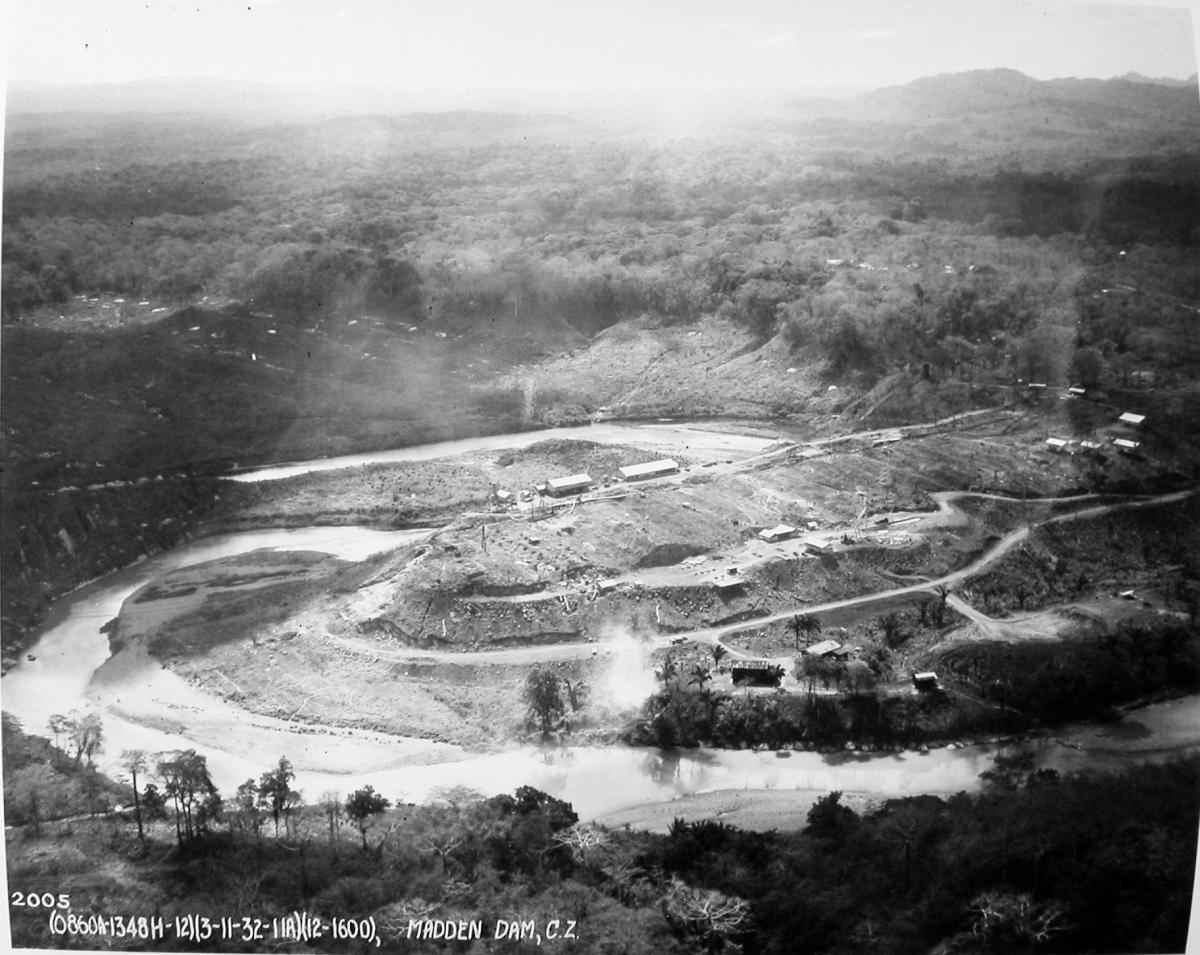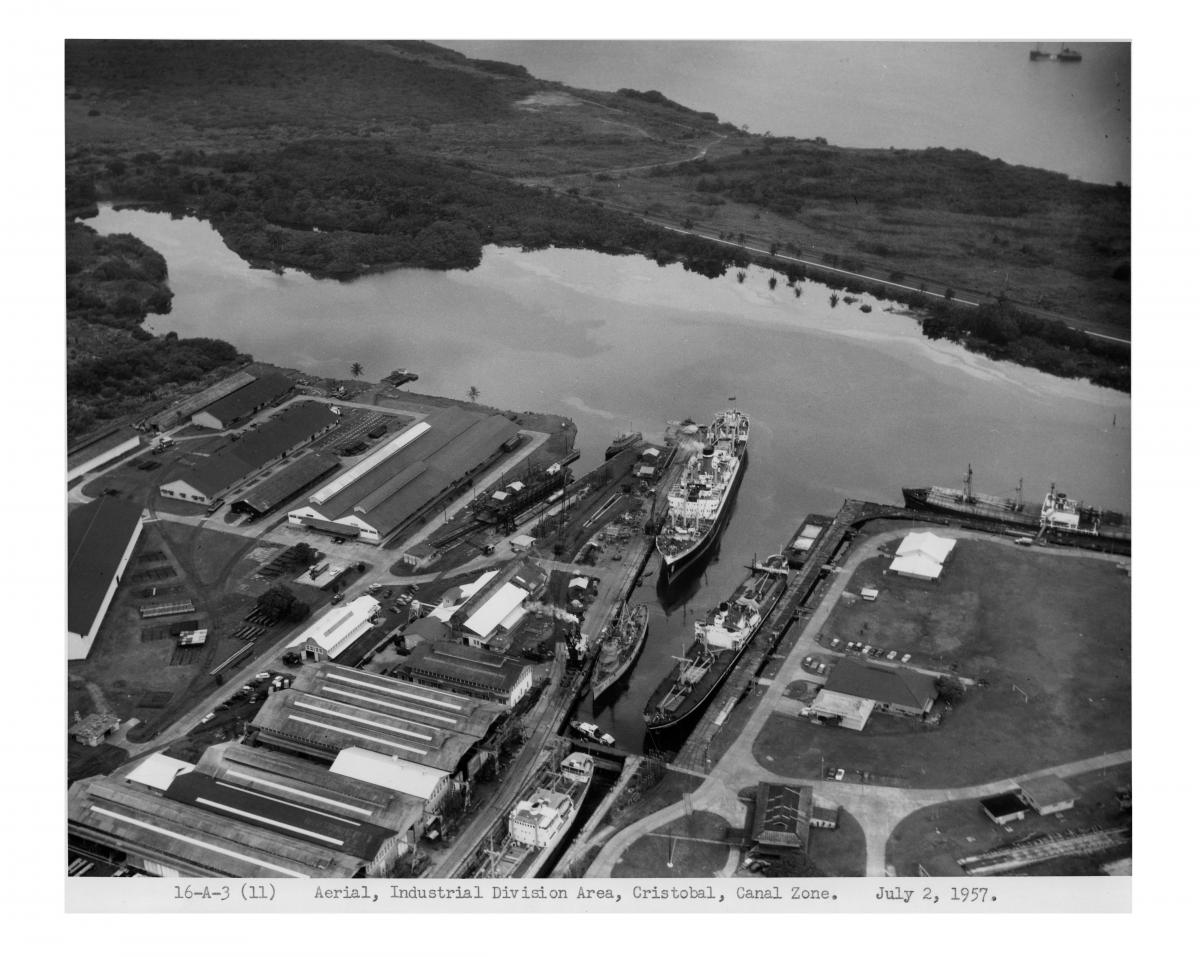
Still Pictures Aerial Photography in Record Group 185: Records of the Panama Canal
Color Photograph Subject Files Relating to Panama Canal Governance, Operations, and Activities, 1979 - 1984 (185-CC)
This series consists of color negatives and corresponding prints documenting operations and activities of the various governmental bodies responsible for maintaining the Panama Canal and associated facilities. Major topics include canal operations and facilities such as dams, locks, spillways, and dredging; vessel transit; views of docks, harbors, barges, bridges, tugboats, and other accessory vessels; aerial views; activities in and improvements to the Gaillard Cut; and buildings. Documentation also includes the visits of high-ranking officials from the United States and other countries and official activities and events of the Governor of the Panama Canal Zone as well as the Panama Canal Board of Directors. Included are images of former Governors Robert John Fleming, David Stewart Parker, and Harold Parfitt. The majority of this series documents ships transiting through the Panama Canal locks. The finding aid for the series is available in the Still Pictures Research Room.
Photographs of the Construction of the Panama Canal, 1887 - 1940 (185-G)
The photographs, some of which are copies of those taken by the French, cover every aspect of construction and early operation of the Canal. Excavation and progressive work on the Culebra and Gaillard cuts; construction and use of the Pedro Miguel and Gatun locks; the Madden Dam and the Balboa Terminals; and aerial images of "before" and "after" construction of the Canal area, are among the subjects. There are individual and group portraits of Goethals, Gargas, engineering staffs, as well as several views of President Taft on his visit to Panama. Also included are pictures of the old Panama Railroad, graves of the early French engineers, buildings, laborer's quarters, Panama City, Colon, Balboa, the Hotel Washington, the SS Bremen and SS Ancon, and physical improvements in living conditions for the inhabitants of the Canal Zone. There are also photographic copies of maps and artworks dating from 1609. The finding aid for the series is available in the Still Pictures Research Room. This series is partially digitized.
Photographs Related to the Operation and Development of the Panama Canal Zone, ca. 1938 - ca. 1960 (185-CZ)
Included in the images are aerial and ground photos of the topography surrounding the Miraflores, Pedro Miguel, and Gatun Locks complexes. The pictures also show various vessels moving into the locks; the procedures used in moving vessels through the locks such as the use of electric locomotives (mules) in towing vessels into the lock chambers; views of the control house in operation with different personnel; and scenes of locks from the decks of ships. Other images document the removal of gates for repair; overhaul of different lock chambers, such as repair of cracks in concrete walls, and the removal of silt. In addition, there are close-up photos of various types of equipment and hardware used in the operation of the locks that required replacement or repair. Many of the images depict naval vessels passing through the canal. These pictures show ships such as the destroyer, USS Asahi, the cruiser, USS Albany, the carriers, USS Boxer, USS Coral Sea, USS Corregidor, and USS Roosevelt; the battleships, USS Iowa, USS Missouri, USS Wisconsin, and USS New Jersey; and various other types of military vessels. In addition there are images of commercial vessels passing through the canal. Included among the photos are the SS Ancon, SS Cristobal, SS Panama, SS America, and others. Another body of images documents the various support facilities not directly related to the operation of the canal. Included in these pictures are exterior and interior scenes of clubhouse facilities. The interior views show soda fountains, dinning areas, pastry shops, cafeterias, and kitchens. Other photos show commissary operations. These pictures show various displays of merchandise such as food, cosmetics, and other dry goods for public consumption. There are scenes of the public purchasing goods in these commissaries; standing in line at the check out counters; and various employees helping customers. In addition, there are images of hotel accommodations indifferent areas of the Canal Zone such as Hotel Washington in Colon, and Hotel El Panama in Panama City. Other photographs document the development of the transportation system throughout the Canal Zone. The photos show a ferry slip at Balboa Bay- close-up views of the slip's construction; tests of a ferry boat using the slip; and the first run of the ferry loaded with automobiles. In addition there are photos showing the development of the Panama Canal railroad system. Included in these pictures are scenes of different types of locomotives at the rail yard; locomotives hauling freight and passenger cars; and locomotives unloaded from vessels at dock side. Included in the photos are scenes of track repair; engineers running the trains; and passengers boarding trains at various stations along the Panama Canal route. There are aerial photographs of the railroad route near Gatun Lake; scenes of a railroad derailment; and views of ships crossing Gatun Lake. There are also images related to different highway systems and residential streets in the Canal Zone. These pictures show the quality of the roads built. Included in these images are Gaillard, Isthmian, and Gamboa highway construction; road crews at work on the improvement of the highway system; damage to the highways due to heavy rain such as landslides, and repair crews at work. Other photos show the development and repair of residential streets, and the laying of concrete in these newly developed areas. Many of the photographs depict construction projects related to residential housing. These pictures show the development of townsites, and of different styles of houses. The images include aerial and ground views at various angles. The photos show multiple housing units such as duplexes, fourplexes, and large apartment units. Also, there are photos of single family homes. Of special interest are pictures of the Governor's home in Balboa. Other photographs illustrate various activities of medical facilities in the Canal Zone. These pictures show different hospitals throughout the Canal Zone; group photos of the professional staff; and medical research on various diseases such as yellow fever. Included are photos of medical teams visiting small villages in the Canal Zone area. The pictures show medical teams going out into Indian villages in an effort to educate natives; inspecting sanitary conditions for evidence of yellow fever; vaccinating the population to prevent yellow fever; and a spraying program throughout the area to eradicate mosquitoes. In addition there are photos showing living conditions of the native population; portraits of Indian women with children; group photos of natives in their villages; and scenes depicting generally poor conditions the natives are living under. Photographs documenting support facilities more directly related to the operation of the canal are also in this series. These pictures include scenes of the Industrial Bureau and the Special Engineering Division's field office, woodwork shop, machine shop, lumber yard, and motor transportation. Among these photographs are images of power plants throughout the Canal Zone. These pictures show aerial and ground views of power plants, and images of electric generators and circuit panels. There are numerous photographs of public schools. These pictures show elementary schools, junior high schools, senior high schools, and junior colleges in the Canal Zone. These images consist mostly of aerial views of buildings and educational activities. The finding aid for the series is available in the Still Pictures Research Room. This series is partially digitized.
Photographs Related to Special Projects and Events at the Panama Canal Zone, 1906 - 1960 (185-SP)
These black and white photographs mounted in albums consist of various subjects related to special events and projects in the Panama Canal Zone. Included are photos of various types of assets transferred to the Panama Canal Company. These pictures include aerial and ground views of Miraflores Locks, Gaillard Cut, Gatun Locks, and numerous buildings in the Canal Zone. There are photos of the overhaul of Gatun Locks. The pictures show workmen repairing various parts of the locks operating equipment. Included are images of repairs on gates, valves, and culverts. Other photos show aerial views of ships moving through the canal. Included are scenes of Gatun, Pedro Miguel, and Miraflores locks in operation; ships moving through Gaillard Cut; vessels passing Contractor's Hill; and ships navigating Gatun Lake. Many of the photographs document the dedication of monuments and celebrations. These pictures show the dedication of George Goethals monument and de Lesseps statue; the 100th year of the Panama Canal Railroad celebration; and the Theodore Roosevelt centennial celebration. The photos show groups of people at track side activities, and at social functions in honor of Theodore Roosevelt. Of interest is a volume of photographs depicting Roosevelt's visit to the canal in 1906. There are photographs related to activities of the Governor of the Canal Zone and various dignitaries. The pictures show the governor at receptions for visiting consultants, Board of Directors, Prince Philip of England, and a lawn party for special guests. Other photos show the governor giving a tour of the canal locks to Queen Elizabeth. In addition there are photographs showing other dignitaries visiting the Canal Zone. These pictures include Latin American leaders such as, Fulgencio Batista, President of Cuba; Juscelino Kubitschek, President of Brazil; Anastasio Somoza, President of Nicaragua; and numerous photos of Vice President Richard Nixon and his wife touring the Canal Zone. Other photos document the progress of construction projects. These pictures show aerial and ground photos related to the progress of work on the construction of schools, railroad stations, sewer lines, and living quarters in various townsites in the Canal Zone. The pictures of townsites show construction on the Pacific and Atlantic sides of the Canal Zone. Included among the images are views of Ancon, Balboa, Cardenas, Diablo Heights, Paraiso, and Balboa Heights on the Pacific side, and views of Gatun, Margarita, and Silver City townsites on the Atlantic side. The photos depict distant scenes and close-ups of home construction; aerial views of future townsites and use of heavy equipment in excavation of townsites; and images of completed homes, water tanks, and industrial buildings. Each townsite is accompanied by a map of the area under construction. Other photographs show work progress on the widening of Gaillard Cut. These images depict the use of heavy equipment, blasting, and dredging the canal. Finally, there are photos showing work progress on the west and east approaches to the construction of a bridge at Balboa. These pictures include views of road construction, use of heavy equipment, pouring concrete forms, and the building of bridge structures. In addition, there are photos of a power conversion project at Gatun, Margarita, and Mount Hope power stations. The images include digging trenches for cables; construction of different power substation buildings; and installing equipment such as electric generators, power panels, switches, and cables. Other photographs show tourists aboard a cruise ship, visiting restaurants, shops, and historical sites in Port-Au-Prince, Haiti. There are also images depicting "Operation Alert", a civil defense operation in 1959. These pictures show various activities of personnel involved with directing the operation. Many of the photographs in this series have no captions. There are no original negatives to the prints in this series. The finding aid for the series is available in the Still Pictures Research Room.

